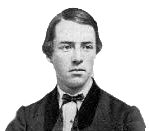Headquarters 5th Army Corps,
Camp near Shepardstown, Sept. 23, 1862.
Dear Hannah, – I have cut out a map from the Philadelphia Inquirer, which gives a fair view of the battlefield of September 17. With the aid of this map and what I have marked upon it, I think, aided by this letter, that you will be able to form a good idea of the battle. Except when carrying messages, I was on the hill marked “Gen. McClellan’s Headquarters,” and had a fine view of the whole affair.

On the map you will see the crescent-shaped ridge occupied by the rebels. Now imagine this long ridge overlooking a hilly and open country in front, which country is full of ravines and cornfields, but free from woods, and lower, mind, than the ridge. The ridge itself is wooded on its summit on the right of Sharpsburg, the Hagerstown pike running parallel and in front of the woods. On the left of Sharpsburg the ridge is mostly free from woods. All that we could see of Sharpsburg was two steeples, the rest of the town being hidden in the valley beyond the ridge. All along this ridge the rebels had batteries placed, both on the right and left of the road. Their infantry, according to their custom, was hidden in the woods. Our batteries were, except on the extreme right, placed on a line of hills parallel to the Antietam, and on the south of it. Our infantry held about the line I have marked in ink. The attack began early in the morning, the artillery on both sides firing rapidly at each other. Soon the musketry on the right grew loud and furious, and we could see our whole line advancing slowly but surely. You see A. That is a school-house in the edge of the wood held by the rebels. Our line advanced nearly up to that, and crept through the cornfield C until they came onto the crest of the hill, where a furious fire from infantry and artillery opened on them, which after a few minutes drove our men back in disorder. It was a dreadful sight, and it made me feel badly, I can tell you. All along the hillside black specks could be seen which we well knew were the dead and wounded on our side. Soon our men rallied, and fresh troops came up and deployed more to the left of the cornfield C. Again we advanced, and this time I could see the rebels run from the cornfield D. Meanwhile Burnside tried to cross the bridge on the left of the map, and after great loss charged across the bridge and took it. He advanced about a mile, but was driven back about half the distance. So it was throughout the whole day. We would advance and get driven back, but would again advance, and the rebels run. Our men on the right broke four times, but were four times rallied, and finally kept the ground they had gained. Very little firing was done in the centre, except artillery. There was one mighty plucky battery on the right. It kept pushing forward, whenever it could get a chance, and banging away at the enemy. Finally it got near D, and there it had three batteries firing on it, with a cross fire. They stood it some time, but finally had to give way, leaving two caissons. As soon as they had got their guns in a safe place, back they went for their caissons and got them away safely. It was a plucky thing and well done.



